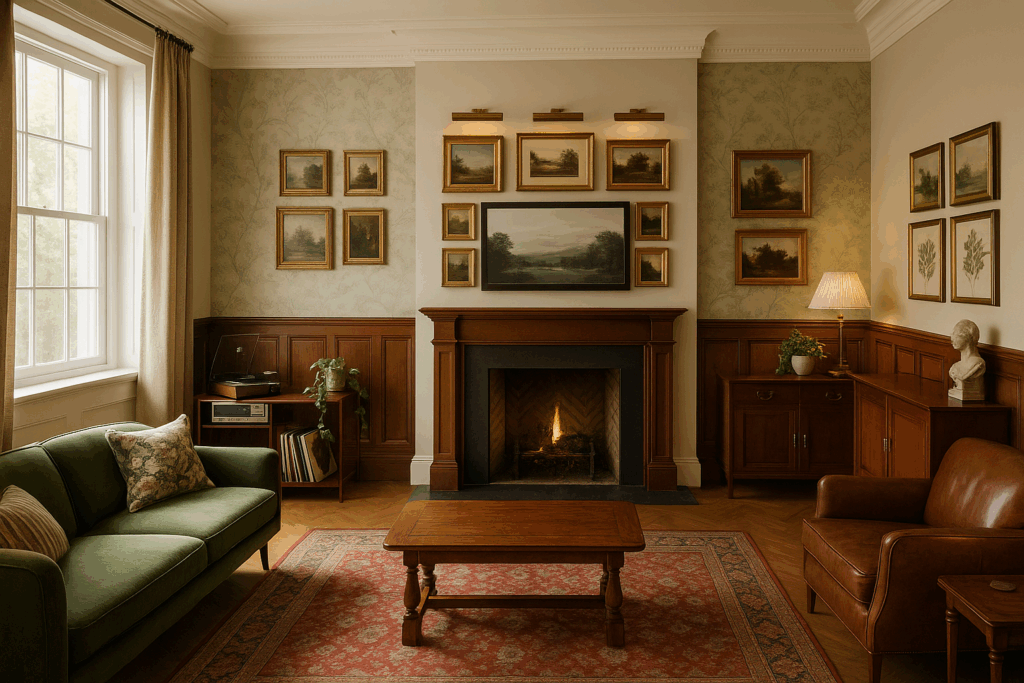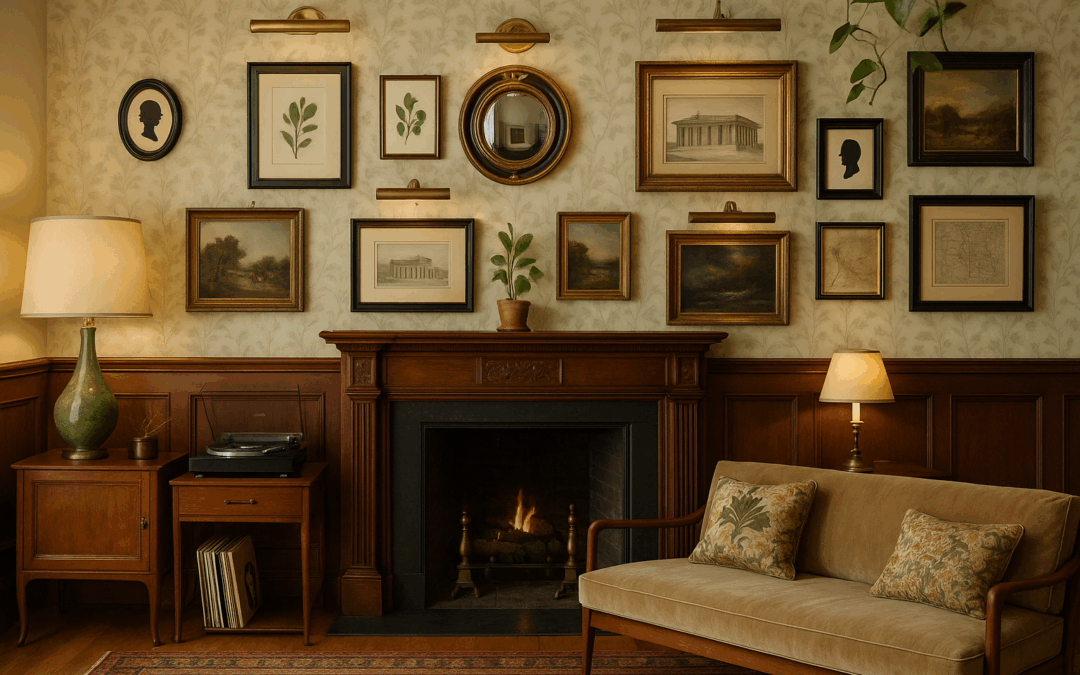The “Old English” look we associate with oak-paneled great halls, Palladian symmetry, and richly patterned Victorian parlors wasn’t born overnight—the history of Old English style goes back over half a millennium and is now being re-energized for the smart-home age. Today’s designers cherry-pick its signature materials (mahogany, brass, damask) while streamlining floor plans and integrating hidden tech. Understanding how the style travelled from Tudor manors to 2025 town-houses helps homeowners decide what details to revive—and which to respectfully retire. This deep dive traces the chronology, highlights the 20th-century lull, and ends with practical pointers for bringing heritage character into contemporary spaces.
The History of Old English Style
Tudor Foundations (1485 – 1603)
Oak, Linenfold & Hearth Culture
The first recognizably “English” interiors emerged under the Tudors, when prosperity from wool and trade funded new manor houses. Walls were sheathed in dark oak paneling, often carved in the fashionable linenfold motif, both insulating rooms and flaunting status. Vast open hearths dominated communal halls, anchoring daily life around firelight and feasting. The National Trust notes that such oak-paneled chambers, four-poster beds, and velvet hangings remain the era’s visual shorthand.
Design takeaway: Full-height paneling can feel heavy in a condo; instead, try half-height wainscoting topped with contemporary botanical wallpaper for a fresh nod to Tudor texture.

Georgian Elegance (1714 – 1830)
Palladian Proportion & Classical Mouldings
Georgian architects embraced symmetry and classical restraint, importing Palladian window ratios and refined cornices. Wall colors lightened to stone, putty, and eau-de-nil, contrasting crisply with white crown Mouldings composed of ogee, ovolo, and bead profiles. Furniture lines slimmed down, favoring walnut and mahogany veneers that balanced grace with durability.
Design takeaway: A simple chair-rail plus balanced artwork grid can evoke Georgian order in an otherwise open-plan layout without feeling fussy.
Victorian Eclecticism & Gothic Revival (1837 – 1901)
Pattern Layering & Medieval Romance
Industrial wealth, global trade, and Queen Victoria’s penchant for nostalgia unleashed a riot of style mash-ups: Gothic arches, Eastlake carving, William Morris wallpapers. Dark woods, stained glass, and elaborate fretwork met upholstered seating and exuberant color. Gothic Revival furniture used pointed arches and tracery to conjure medieval drama—even in city terraces.
Design takeaway: One carved trestle table or a Morris‐print cushion delivers plenty of Victorian flair without tipping into theme-park territory.
20th-Century Decline, Preservation & Film-Set Afterlife
Modernism’s clean lines and mass production pushed “brown furniture” into attics by the 1950s. Yet institutions like the National Trust preserved period houses, keeping scholarship (and salvage yards) alive. Period dramas—from Howard’s End to Downton Abbey—kept the imagery in the public eye, ready for revival once minimalism felt too sterile.
 21st-Century Revival: Context & Catalysts
21st-Century Revival: Context & Catalysts
Micro-Trends That Prepared the Ground
- Cottagecore (2019-24) romanticized pastoral life, vintage floral china, and unfitted kitchens.
- Grandmillennial (2021-24) mixed heirloom chintz with modern art for “traditional-with-a-twist.”
- Dark Academia (2024-25) celebrates mahogany libraries, leather sofas, and scholarly gloom.
2025 Market Drivers
|
Driver |
Evidence | Old English Impact |
| Mahogany comeback | Homes & Gardens confirms brown furniture’s renewed desirability in 2025. | Authentic period timber feels current again. |
| Pantone’s Mocha Mousse | Earthy 17-1230 anchors deeper palettes. Pantone | Validates Tudor/Victorian browns. |
| English Cottage spotlight | Trend forecasters list “English Cottage” among July 2025’s top looks. | Encourages rustic-meets-refined mixing. |
| Sustainable antiques | Veranda predicts a surge in restoring vintage pieces for 2025. | Heirlooms trump fast furniture. |
| Brown furniture = authenticity | Vogue calls the return of English antiques a major 2025 shift. | Provenance adds depth to sleek homes. |
| Layered pattern at London Design Week | Showrooms spotlight heirloom fabrics alongside new prints. | Mix-and-match ethos normalizes heritage motifs. |
| Vintage-meets-modern ethos | Questech’s forecast stresses repurposed classics with minimalist lines. |
Helps Old English blend into open-plan lofts. |
| Reclaimed materials & eco-value | Designers tout reclaimed wood as a top sustainable trend. |
Historic beams gain green credibility. |
Real-World Example
Interior designer Tracey Appel’s 1860 Surrey manor integrates Plain English cabinetry, checkerboard marble, and seamless Wi-Fi—proof that heritage bones and tech can coexist.
Bringing Old English Style History Home: A Few Practical Guidelines
- Anchor with one mahogany statement piece—a sideboard or leather-topped desk grounds an otherwise modern room.
- Install half-height oak paneling then paint the upper wall Pantone Mocha Mousse for instant Tudor-meets-2025 warmth.
- Layer patterns: pair ticking stripes with a single William Morris print for controlled Victorian richness.
- Swap hardware to aged brass; Veranda notes antique brass’s rise over stainless for 2025 kitchens.
- Curate a “snug” corner with a curved velvet sofa (sofa curves stay on trend) and book-lined shelves to satisfy Dark Academia cravings.
- Display botanical or hunt prints in gilt frames—an affordable entry into Georgian and Victorian aesthetics.
- Hide tech in tradition: mount a frame-style TV inside paneling or conceal speakers behind cane grilles for seamless old-meets-new integration.
Conclusion: Heritage With Purpose
Old English style isn’t nostalgia for nostalgia’s sake; it offers sustainable reuse, tactile comfort, and storytelling depth that minimalist spaces often lack. Whether you lean Tudor with oak wainscoting or Georgian with clean cornices, a single antique can recalibrate an entire room’s mood.
If you’re ready to translate centuries of craftsmanship into a home that still embraces smart lighting and open-concept flow, Centerline Design’s Interior Design team can guide every step. And for a deeper dive into bespoke millwork that fits today’s lifestyles, see our post on custom furniture and furnishings.

 21st-Century Revival: Context & Catalysts
21st-Century Revival: Context & Catalysts